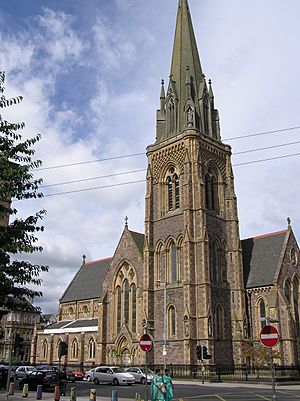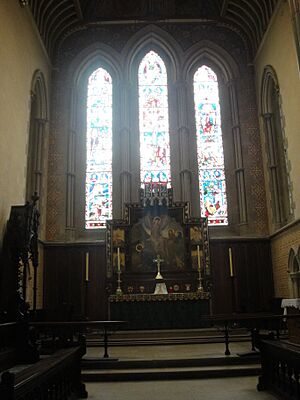St Mary's Cathedral, Glasgow facts for kids
Quick facts for kids St Mary's Cathedral |
|
|---|---|
| The Cathedral Church of Saint Mary the Virgin | |
|
Cathair-eaglais Naomh Moire
|
|

Saint Mary's Cathedral, Glasgow
|
|
| 55°52′25″N 4°16′30″W / 55.8735°N 4.2750°W | |
| Location | 300 Great Western Road, Glasgow G4 9JB |
| Country | Scotland |
| Denomination | Scottish Episcopal Church |
| Churchmanship | Anglo-Catholic |
| Website | Cathedral Website |
| History | |
| Status | Active |
| Dedication | Virgin Mary |
| Consecrated | October 1894 |
| Architecture | |
| Functional status | Cathedral & Parish church |
| Designated | 15 December 1970 |
| Architect(s) | George Gilbert Scott |
| Architectural type | Church |
| Style | Gothic Revival |
| Groundbreaking | 1871 |
| Completed | 1893 |
| Specifications | |
| Number of spires | 1 |
| Spire height | 68 m (223 ft 1 in) |
| Bells | 10 (1901) |
| Administration | |
| Parish | Cathedral congregation |
| Diocese | Glasgow and Galloway |
St Mary's Cathedral is a famous church in Glasgow, Scotland. Its full name is The Cathedral Church of Saint Mary the Virgin. It belongs to the Scottish Episcopal Church. This church is located on Great Western Road in the west end of Glasgow.
The building first opened on November 9, 1871, as St Mary's Episcopal Church. It was fully finished in 1893 when its tall spire was completed. The famous architect George Gilbert Scott designed it. In 1908, it became a cathedral. The entire building stands 63 meters tall. It is a very important historical building, protected as a Category A listed building.
Glasgow has other cathedrals too. These include St Andrew's (Roman Catholic) and St Luke's (Eastern Orthodox). There is also St Mungo's, which is a very old medieval cathedral. Today, St Mungo's is used by the Church of Scotland. This church does not use the word 'cathedral' for its buildings.
Contents
Church Leaders: Rector and Provost
At St Mary's, one person holds two important jobs. They are both the rector for the church members and the provost for the cathedral. The church members choose the rector. The bishop then elects them as provost.
The first provost was Frederic Llewellyn Deane in 1908. He had been the rector for four years already. Kelvin Holdsworth became the current rector and provost on May 31, 2006.
Past Leaders
Many people have served as leaders of St Mary's Cathedral. Here are some of the past rectors and provosts:
- Richard Samuel Oldham: He was a leader from 1851 to 1878.
- Frederic Edward Ridgeway: He served as rector from 1878 to 1890.
- Frederic Llewellyn Deane: He was the first provost from 1908 to 1917.
- Ambrose Lethbridge: He served as provost from 1918 to 1927.
- Malcolm Etheridge Grant: He was rector and provost from 1981 to 1991.
- Philip (Griff) Dines: He served from 1997 to 2005.
Who Attends St Mary's?
St Mary's Cathedral has two main purposes. It serves as the main church for the diocese (a church area). It is also a large church for people living in and around Glasgow. Many people from different areas come to worship here.
Church members are very involved. They help with worship, manage activities, and do outreach work. Outreach means helping the community.
Music and Arts at the Cathedral
St Mary's is in a great spot in Glasgow. It tries to be a center for art and culture. The cathedral often hosts concerts, art shows, and other events. This helps it connect with more people.
Music is a very important part of worship here. The cathedral has a choir of adults. They sing at a professional level. Friðrik (Frikki) Walker is their Director of Music. In 2007, younger singers (trebles) joined the choir.
The church has a large organ. It has three keyboards. It was built by William Hill. The organ was fixed up in 1967 and fully restored in 1990. The cathedral also has ten bells. The largest bell weighs about 1.6 tons!
Music Directors
- Friðrik Walker (1996-present)
Cathedral Organists
Many talented people have played the organ at St Mary's.
- George Pattman (1904–1917)
- Friðrik Walker (1996 – current, now also Director of Music)
- Steven McIntyre (2023 - current)
Assistant Organists
- Friðrik Walker
- Steven McIntyre (2014 - 2023)
Organ Scholars
Organ scholars are students who learn to play the organ.
- Mark Browne (2004–2005)
- Christopher Hampson (2005–2006)
- Eilidh Harris (2023 - current)
Restoring the Cathedral
From the mid-1980s to 2002, St Mary's Cathedral went through a big restoration project. This means they repaired and updated many parts of the building.
Phase 1: Fixing the Center
Water was leaking into the organ area. This caused serious damage to the beams supporting the central part of the church. Repairs were done. A full check of the building's condition was made. After this, a project to raise money started in 1986.
Phase 2: Chancel and Organ
The chancel (area around the altar), tower, and central crossing were repaired. The roof was replaced. The windows high up in the walls were fixed. While this work was happening, the organ was completely taken apart and rebuilt.
A special ceremony happened on December 19, 1989, at the top of the spire. The cathedral choir sang Christmas songs. In 1990, the choir visited seven other cathedrals in Scotland. This trip helped raise money for the organ repairs.
Phase 3: Synod Hall
The roof of the Synod Hall was replaced. New lights and toilets were added. A choir room was created. The bishop's changing room was replaced with a toilet for people with disabilities. A lift was installed to help people move between floors. The old small kitchen was replaced with a new catering area.
This was the biggest part of the restoration. The church members had to worship at a nearby church from October 2000 to March 2002. During this time, a new glass entrance porch was built. New floor tiles were laid. Special decorations by Gywneth Leech were finished. A new lighting system was also put in.
Early History of the Congregation
People believe the church community started in 1715. However, records from 1713 show it might be even older. In 1689, the Scottish Parliament changed the way the Church of Scotland was set up. This led to the Scottish Episcopal Church becoming a separate group.
At first, not many people in Glasgow supported the Episcopal Church. But some families in Glasgow had Episcopal beliefs. They also supported the Jacobites, who wanted to bring back the old royal family. These families kept a low profile for a while. They became more open after Queen Anne became queen in 1702.
The first report of the church community is from 1703. It describes a service held to remember the execution of King Charles I. This service caused a riot! At this time, several priests were involved.
In 1712, a priest named William Cockburn arrived. He was willing to take an oath to the king, which made his church 'qualified' and legal. He set up a meeting-house. In 1713, he also marked the death of Charles I. A list of his church members shows important Glasgow families. This chapel was attacked after Queen Anne died.
Members of the church community fought in the Battle of Sheriffmuir in 1715. They fought for the Old Pretender. Many of them had to flee or lost their property. The church community survived, but it was smaller and poorer. Laws against Scottish Episcopalians became very strict.
In 1728, a new meeting house opened. But it was soon closed by the city leaders. The priest, Alexander Duncan, then held services in his own home until he died in 1733.
Information about the early Episcopal church in Glasgow is limited. They used a Bible and a prayer-book, probably the Book of Common Prayer. They also had sermons. They had Holy Communion at Christmas and Easter. Baptisms happened, even though they were sometimes against the law. Episcopal priests visited the sick and led funerals. The church also collected money to help the poor.
After 1745, laws against Scottish Episcopalians became even harsher. Priests like George Graham and David Lyon continued to lead the community. From 1751, Episcopalians who accepted the new king could attend a 'qualified chapel' called St Andrew's-by-the-Green.
Later priests included Andrew Wood and Andrew Macdonald. Macdonald was a writer of novels, poems, and plays. The strict laws against Episcopalians were finally removed in 1792. The church community grew. For many years, they met in a classroom. In 1825, they moved to St Mary's Chapel. Then, in 1871, they moved to the building we see today.


